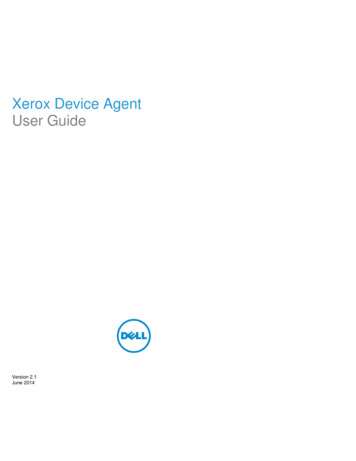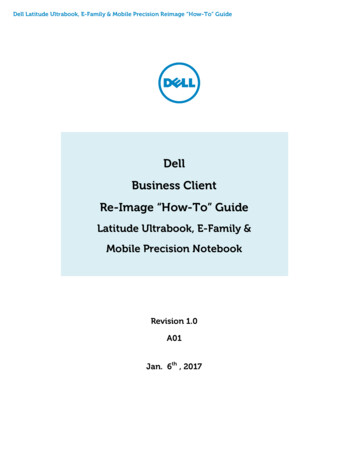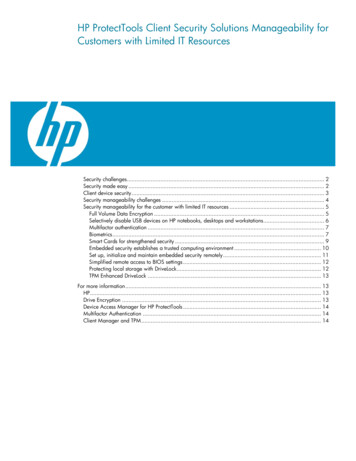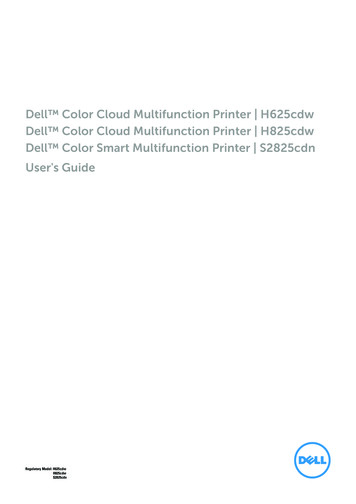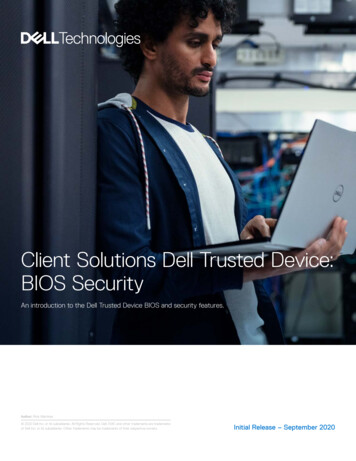
Transcription
Client Solutions Dell Trusted Device:BIOS SecurityAn introduction to the Dell Trusted Device BIOS and security features.Author: Rick Martinez 2020 Dell Inc. or its subsidiaries. All Rights Reserved. Dell, EMC and other trademarks are trademarksof Dell Inc. or its subsidiaries. Other trademarks may be trademarks of their respective owners.Initial Release – September 2020
Table of ContentsExecutive summary . . . . . . . . . . . . . . . . . . . . . . . . . . . . . . . . 3The Key Elements of Dell BIOS Security . . . . . . . . . . . . . . . . . . . . . 4What is BIOS? What is UEFI? . . . . . . . . . . . . . . . . . . . . . . . . . . . 4The Importance of “Below the OS” Security . . . . . . . . . . . . . . . . . . . 5NIST Cybersecurity Framework . . . . . . . . . . . . . . . . . . . . . . . . . . 6Identify . . . . . . . . . . . . . . . . . . . . . . . . . . . . . . . . . . . . . . 6Identity and Asset Management Tags . . . . . . . . . . . . . . . . . . . . . . . 6SDL . . . . . . . . . . . . . . . . . . . . . . . . . . . . . . . . . . . . . . . . 7Secure Design Processes and SDL . . . . . . . . . . . . . . . . . . . . . . . . 8Industry Affiliations . . . . . . . . . . . . . . . . . . . . . . . . . . . . . . . . 8“Below the OS” Threat Modeling . . . . . . . . . . . . . . . . . . . . . . . . . 8Protect . . . . . . . . . . . . . . . . . . . . . . . . . . . . . . . . . . . . . . 9The PC Boot Process . . . . . . . . . . . . . . . . . . . . . . . . . . . . . . . 9UEFI Secure Boot Expert Mode . . . . . . . . . . . . . . . . . . . . . . . . . . 11Signed Firmware Update . . . . . . . . . . . . . . . . . . . . . . . . . . . . . 11NIST SP800-147 Support . . . . . . . . . . . . . . . . . . . . . . . . . . . . .12Mitigating SMM Threats with Intel BIOS Guard . . . . . . . . . . . . . . . . . 12What is SMM? . . . . . . . . . . . . . . . . . . . . . . . . . . . . . . . . . . .12Mitigation: Intel BIOS Guard . . . . . . . . . . . . . . . . . . . . . . . . . . . .13BIOS Patch Management . . . . . . . . . . . . . . . . . . . . . . . . . . . . .13BIOS Downgrade Protection . . . . . . . . . . . . . . . . . . . . . . . . . . . 14Embedded Controller: Signed Firmware . . . . . . . . . . . . . . . . . . . . . 14Protecting BIOS Configuration . . . . . . . . . . . . . . . . . . . . . . . . . . 14Protecting BIOS at Runtime . . . . . . . . . . . . . . . . . . . . . . . . . . . . 17Detect . . . . . . . . . . . . . . . . . . . . . . . . . . . . . . . . . . . . . . 19Intel Boot Guard . . . . . . . . . . . . . . . . . . . . . . . . . . . . . . . . . .19SafeBIOS Verification . . . . . . . . . . . . . . . . . . . . . . . . . . . . . . 20BIOS Indicators of Attack . . . . . . . . . . . . . . . . . . . . . . . . . . . . .21Chassis Intrusion . . . . . . . . . . . . . . . . . . . . . . . . . . . . . . . . . 22TCG Measured Boot . . . . . . . . . . . . . . . . . . . . . . . . . . . . . . . 22Recover . . . . . . . . . . . . . . . . . . . . . . . . . . . . . . . . . . . . . 24Embedded Controller Recovery . . . . . . . . . . . . . . . . . . . . . . . . . 24BIOS Recovery . . . . . . . . . . . . . . . . . . . . . . . . . . . . . . . . . . 24Dell Data Wipe . . . . . . . . . . . . . . . . . . . . . . . . . . . . . . . . . . 26Supply Chain Assurance . . . . . . . . . . . . . . . . . . . . . . . . . . . . . 27Protected Signing Infrastructure . . . . . . . . . . . . . . . . . . . . . . . . . 27The Future of Security . . . . . . . . . . . . . . . . . . . . . . . . . . . . . . 28Appendix . . . . . . . . . . . . . . . . . . . . . . . . . . . . . . . . . . . . . 29Referenced Links . . . . . . . . . . . . . . . . . . . . . . . . . . . . . . . . . 29Learn More . . . . . . . . . . . . . . . . . . . . . . . . . . . . . . . . . . . . 30Acknowledgements . . . . . . . . . . . . . . . . . . . . . . . . . . . . . . . 30About the author . . . . . . . . . . . . . . . . . . . . . . . . . . . . . . . . . 30
Executive summaryComputer security is a multi-billion dollar business with thousands of companies competing fororganizations’ attention and enterprise dollars. Dell Technologies has created an innovative and effectiveportfolio of technologies and solutions in this industry to help organizations secure their enterprises. One ofthe areas where Dell has substantially invested over the last decade is security of the endpoint itself, in thiscase the “client” device (desktops, workstations, and notebooks) known as the Dell Trusted Device.This investment in the endpoint is significant for security of course but don’t firewalls, IDS/IPS, SIEMs,NGAV, EDR and all the various alphabet soup of enterprise-level security tools already cover everything?Well, yes and no. Dell believes that the security of the infrastructure not only depends on these tools,but also on the intrinsic security of each individual endpoint. From this perspective the endpoints, andsubsequently each individual device, collectively become the foundation of security for the entire enterprisecomprising of edge devices, networks, IoT devices, and beyond.One of the most critical and fundamental tenets in computer security is transparency. Though highlyeffective, security features deeply embedded within a client are not always visible. The intent of thispublication is to provide transparency into the Dell Trusted Device security features and technologyimplementations as provided and enforced by the code responsible for device boot and other fundamentaldevice functions, which we refer to as our BIOS (Basic Input/Output System).This whitepaper was written to provide a thorough introduction to the Dell Trusted Device BIOS and,more specifically, the BIOS security features and hardening. The BIOS remains an extremely importantcomponent in a modern PC, and some of the more foundational (and critical) security hardening aspects ofthe device start with and depend on the BIOS. This document will unwrap the terminology and lexicon thathas tightly attached itself to this area of technology and explain the individual features and components ofthe BIOS that help to secure enterprise infrastructure from the device up to the cloud.The intended audience for this document includes security operation center (SoC) analysts, IT adminsand decision makers (ITDMs), IT support personnel, compliance and risk/governance teams, securityresearchers and analysts, and anyone else interested in learning more about the intrinsic security offeredby the Dell Trusted Device via security and hardening of the underlying BIOS and firmware. Contextuallythis document is broken into sections that map to the five functions defined in the NIST CybersecurityFramework: Identify, Protect, Detect, and Recover. This should help put each feature included in the DellTrusted Device into the perspective of the overall goal of helping to secure each organization’s enterprise.Examples of topics covered within this context in the remaining sections are: Identify: asset management and secure design principles proactively contributing to security(e.g. Dell Service Tag, Threat Modeling)Protect: defensive technologies to harden non-volatile storage and the boot process(e.g. Signed Firmware Update, BIOS Passwords)Detect: ability to convey status when unauthorized changes occur(e.g. SafeBIOS Verification, Intel Boot Guard)Recover: advanced mitigations to quickly remediate issues(e.g. BIOS Recovery, Dell Data Wipe)This document concludes with a brief section on Supply Chain Assurance and a commitment to the ongoingDell investments helping to shape the future of security. This document is not the end of the conversationabout the Dell Trusted Device: hopefully it’s the beginning of a long and bi-directional discourse beneficial tothe industry overall.3
The Key Elements of Dell BIOS SecurityWhat is BIOS? What is UEFI?The “BIOS” in a modern PC remains one of the most misunderstood components of the firmware andsoftware stack. The mere mention of “BIOS” to anyone that’s been in the industry for more than adecade evokes memories of resetting the CMOS battery or toggling jumpers on the motherboard to makeconfiguration changes. Many still refer to the BIOS configuration menu, or “BIOS Setup” as the BIOS, butthere is so much more to it than that!For the purposes of this document, the BIOS refers to the pre-boot firmware that the main processorexecutes at the beginning of every boot and any code that remains resident at runtime that was deployedby the pre-boot firmware. The role of this pre-boot firmware is to initialize memory, configure chipset anddiscrete devices on the motherboard, provide PC OEM unique features, and to enforce any customerspecific configuration settings managed by BIOS Setup.Additionally, more recently the term “UEFI” has become much more prominent when discussing pre-bootfirmware on PCs, and while architecturally the UEFI ecosystem has had a net positive effect on compatibilityand ease of deployment, the term itself has managed to confuse the issue. UEFI, or the Unified ExtensibleFirmware Interface, is an industry forum and specification that defines the various optional interfaces andprotocols used by pre-boot firmware to configure a PC (in most cases). Many experts pedantically correctothers that “UEFI has replaced BIOS!” but that’s only partly true. The truth is, PC OEMs and most subjectmatter experts in the field still use the term “BIOS” to refer to any pre-boot firmware designed to bootstrapa modern PC, regardless of whether it is UEFI-based, Linux-based, or completely custom.One of the other net positive effects of UEFI has been the opportunity to integrate features and devicedrivers that are compatible with the UEFI specification directly into the BIOS development flow. An excellentexample of this in practice is the UEFI Tianocore project on Github. Tianocore is the current referenceimplementation for UEFI and is completely open source. Dell and other OEMs use some of this project codeas the foundation or “core” BIOS and add differentiated features on top of the open source core. Anotherbenefit of this open architecture is that UEFI supports architectures well beyond Intel x86-based PCs.4
The Importance of “Below the OS” SecurityDell UniqueRespondDetectPreventIndustry StandardDell BIOS RecoveryDell SafeBIOS Image CaptureDiscrete TPMRuntime BIOS ResilienceDell SafeBIOS VerificationTCG Measured BootDell SafeBIOS IoADowngrade ProtectionFused Root of TrustIntel BIOS GuardDell UEFI Secure BootIntel Boot GuardBIOS PasswordsAuthenticated UpdatesBIOS Public KeysFigure 1 Trusted Device: Dell SafeBIOS FrameworkAs mentioned in the executive summary, the security of endpoints collectively form the foundation of theentire enterprise. Consider the analogy of a house to represent endpoint security. An organization’s mostvaluable assets - data and sensitive information – are like the family inside this house. Houses however arenot intrinsically secure, so homeowners must build or buy additional protections like deadbolts, securitycameras, and motion sensors to help secure them. Jumping back to the enterprise: there are plentyof players in the security ecosystem which offer these additional protections, but what’s the remaininggap in this scenario? The foundation. Any dwelling must be built on a stable foundation to protect thehomeowner’s investment in security from being subverted from below. That’s where the Dell Trusted Deviceand BIOS security comes in!Dell refers to this stable foundation as “Below the OS”, and the Dell SafeBIOS Framework refers to allsecurity features implemented to secure the device beneath the operating system. Based on the analogyabove, it’s clear that the endpoints and this below the OS foundation are valuable targets for adversariesattempting to get a foothold into an enterprise. This critical role in our customers’ security is why Dell hasinvested in below the OS security for over a decade and why it’s important that we publicly document theSafeBIOS features and some of the rationale behind their development.Industry standards bodies, policy makers, and security researchers have recently started to focus on belowthe OS security as well. Dell has been very involved in contributing to, and building devices that adhereto, recommendations from NIST around firmware security and resilience. Most recently, NIST SpecialPublication SP800-193 has outlined overall resilience guidelines for device firmware (including BIOS) andhas been helpful in confirming the value in Dell’s below the OS security investments and direction.Other NIST Special Publications that are relevant in this space include NIST SP800-147, which definesguidelines for protecting the BIOS and specifies that only signed and authorized BIOS should run on thedevice (see the Dell Client Signed Firmware Update whitepaper here).NIST SP800-88 provides direction fordata sanitization on hard drives and solid-state drives.5
It’s clear that industry and customer interest for “Below the OS” and firmware/BIOS security has risenin the last few years. This awareness is incredibly valuable because it allows Dell to continue to improvethese areas year over year and help protect Dell Trusted Device customers from the most sophisticatedadversaries.NIST Cybersecurity S security can be categorized according to the five functions of the NIST Cybersecurity Framework:Identify, Protect, Detect, Respond, and Recover. The remaining sections of this document will detail theBIOS features and below the OS security technologies that align to these functions and explain how theywork and why they are important. More information about the NIST Cybersecurity Framework can be foundhere: https://www.nist.gov/cyberframework.DetectFigure 2 NIST Cybersecurity Framework - Five FunctionsIdentifyThe Dell Trusted Device and BIOS security features map directly to the Protect, Detect, and Recover/Respond functions of the NIST Cybersecurity Framework. The Identify function maps closely as well butthe interaction is a bit more complex. For most enterprises, the Cybersecurity Framework is an effectivetool for assessing security risk in their environments, where identifying assets and risk is a broad butvaluable exercise. For the Dell Trusted Device the Identify function has two important but separate roles:1. Includes features designed to help identify and asset-manage Dell Trusted Devices in a customerinfrastructure.2. Addresses processes and tools used by Dell to Identify customer security risks and threat models of theapplication and deployment of these devices.Identity and Asset Management TagsThe Dell Trusted Device BIOS supports two independent persistent identifiers (or “tags”) to allow customersto discover and manage their devices in their infrastructure.6
Service TagThe Service Tag is programmed into the BIOS NVRAM (non-volatile random access memory) during themanufacturing process and is locked in place for the life of the device. This allows the customer and Dell toidentify the device for overall asset management in the customer enterprise and enables Dell to confirm thedevice information for service and warranty support. The BIOS is responsible for displaying the Service Tagin BIOS Setup and in management interfaces such as SMBIOS. The Service Tag is not changeable by thecustomer.More information about the Service Tag can be found in the Dell Knowledgebase here te-service-tag.Asset TagThe Asset Tag is also stored into BIOS NVRAM and can be set, changed, or cleared by the end customer.The Asset Tag is displayed in text on the Dell boot splash screen on every boot and can be used foradditional customer-specific tracking information, logistical messages, or unique branding. The BIOSAdministrator password can be used to provide authentication and authorization controls to control AssetTag modification.More information about the Asset Tag can be found in the Dell Knowledgebase here cleMaintenanceRelease /ResponseImplementationVerification /TestingFigure 3 Dell EMC Security Development Lifecycle7
Secure Design Processes and SDLDell’s Secure Development Lifecycle (SDL) shown in Figure 3 integrates standards and best practices froma variety of industry consortiums and standards bodies. A primary consideration in SDL is to blend datasources from both internally discovered and externally reported issues, allowing Dell to focus on the mostprevalent issues in the Dell Trusted Device technology space. A second major consideration is industrypractices. Dell participates in many industry standard organizations such as SAFECode, BSIMM, and IEEECenter for Secure Design to ensure alignment to industry practices. Lastly, Dell’s Secure DevelopmentLifecycle is aligned with the principles outlined in ISO/IEC 27034 ‘Information technology, Securitytechniques, Application security’.Industry AffiliationsDell is active in multiple industry-wide groups to collaborate with other leading vendors in defining, evolving,and sharing best practices on product security, and in further enhancing the cause of secure development.Examples of industry collaboration include: Dell co-founded and currently chairs the Board of Directors of The Software Assurance Forumfor Excellence in Code (SAFECode: https://www.safecode.org). Other board members includerepresentatives from Microsoft, Adobe, SAP, Intel, Siemens, CA and Symantec. SAFECode membersshare and publish software assurance practices and training. Dell is an active member of the Forum of Incident Response and Security Teams (FIRST:https://www.first.org). FIRST is a premier organization and a recognized global leader in incident andvulnerability response. Dell is an active participant in The Open Group Trusted Technology Forum trusted). OTTF leads the development of a globalsupply chain integrity program and framework. Dell was among the 9 companies that were first assessed by the Building Security In Maturity Model(BSIMM: https://www.bsimm.com/) project back in 2008 and has continued to be part of the project. ADell representative is part of the BSIMM Board of Advisors. Dell employees were founding members of the IEEE Centerfor Secure Design, which was launched under the IEEE cybersecurity initiative to help software architects understand andaddress prevalent security design flaws.“Below the OS” Threat ModelingThreat modeling is the exercise of using an adversarial mindsetto evaluate computer architectures to determine potentialvulnerabilities or attack surface early in the development phase.Most threat modeling information that is
the areas where Dell has substantially invested over the last decade is security of the endpoint itself, in this case the “client” device (desktops, workstations, and notebooks) known as the Dell Trusted Device. This investment in the endpoint is significant for securit
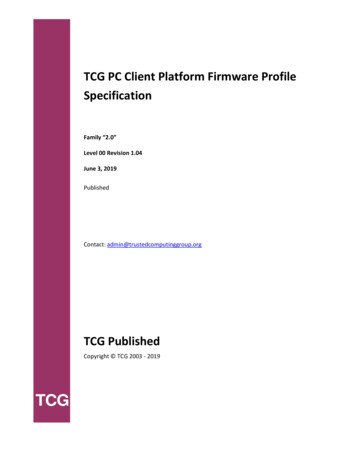
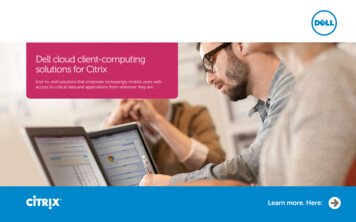

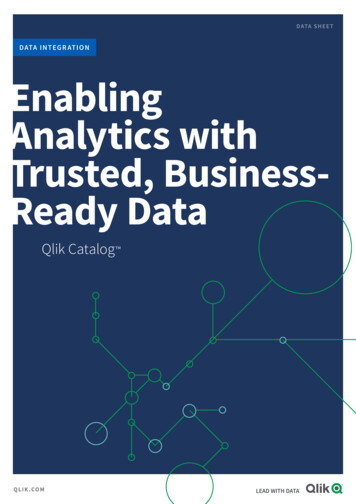
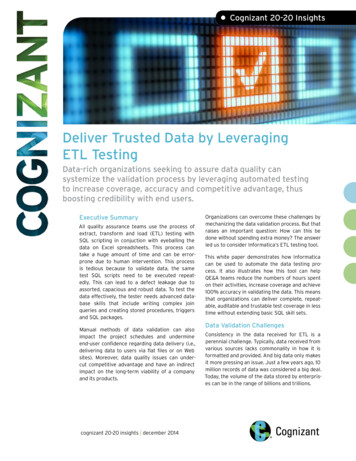
![Trusted Computer System Evaluation Criteria ['Orange Book']](/img/12/dod85.jpg)
